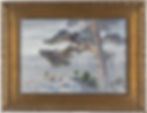Bird in the Spotlight: Western Capercaillie
- IBCP
- Apr 25
- 3 min read
Updated: Sep 22
25 April, 2025

Western Capercaillie in Estonia. Photo by Tõnu Pani, CC BY-SA 3.0, via Wikimedia Commons.
It’s a bird, it’s a horse… it’s a capercaillie? What’s a capercaillie?! A bird of superlatives, the Western Capercaillie (Tetrao urogallus) is the largest living grouse species, with a range stretching from Europe to Siberia. In the Phasianidae (Pheasants, Grouse, and Allies) family, males undergo intense competition to be chosen by females, in many cases distinguishing themselves by magnificent plumage, such as in the Indian peacock (Pavo cristatus), or massive size, or both. Capercaillie males are nearly twice the size of females, with the heaviest known bird weighting over 7 kilos (16 pounds).

Female Capercaillie in Sweden. Photo by Lars Falkdalen Lindahl, CC BY-SA 2.0, via Wikimedia Commons.
Native to boreal and coniferous mountain forests, male capercaillies put on spectacular courtship displays on leks, or gatherings of males named for the Swedish word for “play.” The capercaillie’s English name originates from a Scottish Gaelic description meaning “horse of the woods,” in reference to its size and strength. With males focused on competing with each other and defending their territories, females raise chicks without male assistance.

“Capercaillies Courting,” a painting by Finnish artist Ferdinand von Wright.
Capercaillies’ devotion to perfecting their displays of beauty and power and wooing potential mates have long inspired people. They appear on dozens of coats of arms across Europe and Russia and have been called the king of game birdsand the most coveted game bird in the world.

A hunter carrying a capercaillie is shown in this painting by Swedish artist Gustaf Cederström on display in Stockholm.
Capercaillie also feature in culturally significant art. An award-winning painting featured in Stockholm’s National Museum, for example, entitled, “Bringing Home the Body of King Karl XII of Sweden,” depicts the repatriation of Sweden’s king after his 1718 death during the Great Northern War, marking a significant turning point in the history of Scandinavia.

Capercaillie displaying at a lek in Austria. Photo by Nudelbraut, CC BY-SA 3.0, via Wikimedia Commons.
Widespread appreciation of capercaillies in many countries unfortunately has not spared them from declining due to human activities, especially commercial forestry operations that have damaged or destroy the forests they call home and need to survive. The capercaillie was extirpated from Scotland during the 18th century, and although successfully reintroduced from Sweden in the 19th century, it now appears again to be on the brink of extinction in the land that gave it its name. Capercaillies have also declined or disappeared from many other areas of Europe, such as Ireland, France, and Bavaria, where they are a part of both the natural and cultural heritage. The plight of the capercaillie is the subject of poetry as well as many conservation efforts.

Capercaillie depicted on a Russian stamp.
Fortunately, capercaillie strongholds remain, including in northern Fennoscandia and Russia, where they thrive in forests untouched by logging operations. Here, females have been found to prefer nesting in moist spruce forest rich in bilberries (Vaccinium myrtillus), which host insect larvae crucial for the development of their chicks. Fortunately, although capercaillie conservation in human-dominated regions faces many challenges, ongoing studies of specific responses to human impacts and how to manage these, are helping to point the way forward.

“Capercaillie Cock with Hens” by Swedish artist Bruno Liljefors.
